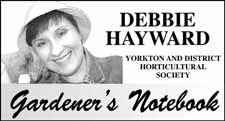Get a cup of tea, gardeners, and let's talk about another chapter from that great book, "The Landscape Makeover Book: How To Bring New Life To An Old Yard", by Sara Jane von Trapp. I was looking at the chapter called "Pruning Simplified", and thought that might be a timely one for us to consider. Sara calls pruning "the simplest form of landscape renovation and it achieves dramatic results if done properly."
Okay, there's the catch: "if done properly". What does that mean? We know that certain times are better than others for pruning, and we can't just go into our yards, hedge trimmers blazing, and start hacking away at our trees and shrubs.
First, we have to understand why we are pruning in the first place. We might be trying to make a tree or shrub smaller or more shapely. Pruning can help a plant grow better, by forcing the plant to put its energy into the branches that are remaining, making them more vigorous. Pruning can also make a plant healthier. For example, (and you've heard me talk about this before), junipers that are too dense and overgrown are perfect candidates for problems, because there is no air circulation, and the sunlight can't get at parts of the plant, and then it starts to die back, often in the middle. We're left with a rusty, scratchy, tangled mess. Judicious pruning might seem drastic, but will help the shrub in the long run.
Sara says that we should check the growth habits of the tree or shrub we want to prune. If it is meant to cascade, we shouldn't be trimming off every branch that is trying to arch gracefully downwards.
When do we prune? Sara's book says that we should never prune when the plant is getting ready to go dormant. Pruning stimulates growth, and this new growth won't be strong enough to survive the winter. So her suggestion is to stop pruning from late summer until after the plant is dormant. Once the plant is dormant, it is once again all right to prune, because there won't be any new growth till spring.
If you've ever watched any cooking programs on TV, the chefs always say that if you cut yourself in the kitchen, it will hurt less with a sharp blade. And so it goes for our trees and shrubs. Be sure that your saws, shears, and loppers are all clean and sharp. Be sure to clean them after you are done with them, too, so that they will be ready for the next pruning session. In her book, Sara is not a big fan of chain saws except where they are truly needed (for very large projects). In her opinion, hand tools offer more control and less damage to the tree or shrub. She points out that if we damage the tree or shrub while pruning it, the energy of the tree must go into healing, rather than into growing. That's a very good point, and one that we should keep in mind.
Maybe another time we can talk about pruning roses, because they are more special and specialized than regular shrubs in terms of what they need for care.
Some other basics: always prune each branch individually. Make an angled cut, just above a bud. Thin out thick, old stems in shrubs to promote new growth and improve the overall look of the shrub; but do this gradually over two or three years. When removing these old branches, cut them right down to the ground, do not leave any stumps. Remove any dead branches for an instant "facelift". Remove any crossing branches, or any branches that are rubbing against each other.
There is so much to learn about this, so do your homework before you begin, and cut with care. Once a branch is gone, it will take years for the tree or shrub to grow another like the one you have just lopped off, so consider your work carefully.
The Sask. Horticulture al Association presents their 6th Annual Bus Tour, July 17-19. All interested gardeners are welcome on this mini-getaway, which goes to Saskatoon this year. Your fee includes the bus ride, accommodations, and admission to all the sights on the tour. For all the details, call Liz at 782-2830. And remember, the Yorkton In Bloom contest is coming up: I'll find out some details and tell you about them soon.
Till next time, have a good week; good luck with your pruning!




